Every so often, we get a product that feels like it is breaking new ground bringing high performance to a lower power and compact footprint. This feels like one of those moments. The MikroTik CRS504-4XQ-IN is a 4-port QSFP28 switch that offers up to 4x 100GbE links at a sub $699 price point. What is more, the compact package sips power and is quiet enough that many may put it in an office without even attempting a fan swap. Although it is not perfect, this is a momentous experience for homelabs and SMB networking.
MikroTik CRS504-4XQ-IN Review Video Version
Of course, we had to have a video for this one that you can find here:
If you want to listen to the switch, see live power consumption figures, or just listen along, check this video out. As always, we recommend opening it in its own browser, tab, or app for the best viewing experience.
If you want to find the version we reviewed, you can check out the Amazon Affiliate link here.
MikroTik CRS504-4XQ-IN Hardware Overview
The switch itself is a “IN” unit which is generally for desktop units in MikroTik naming. The “-RM” is typically for rackmount units. While the CRS504-4XQ-IN is a 1U switch, the extended rack ears are optional. We showed them briefly in the video.
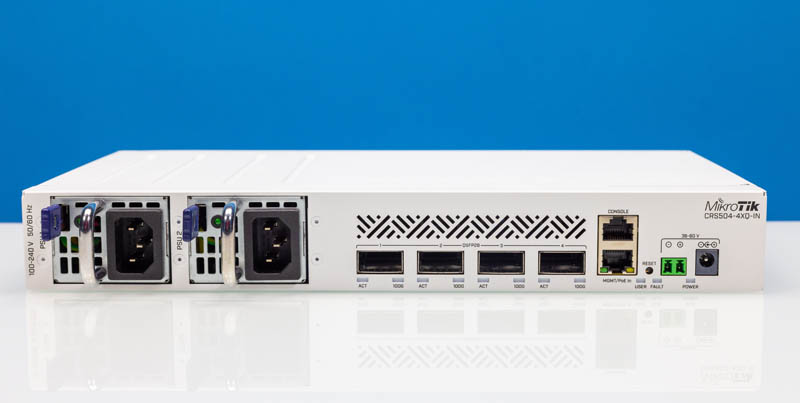
On the left, there are redundant 60W power supplies. We will get to the power consumption later, but the fact that these are only 60W should give some sense of how little power the switch uses. Also, redundant swappable power supplies in a sub $700 switch is a feature that other vendors often omit in this price range, let alone in a sub $700 100GbE switch.
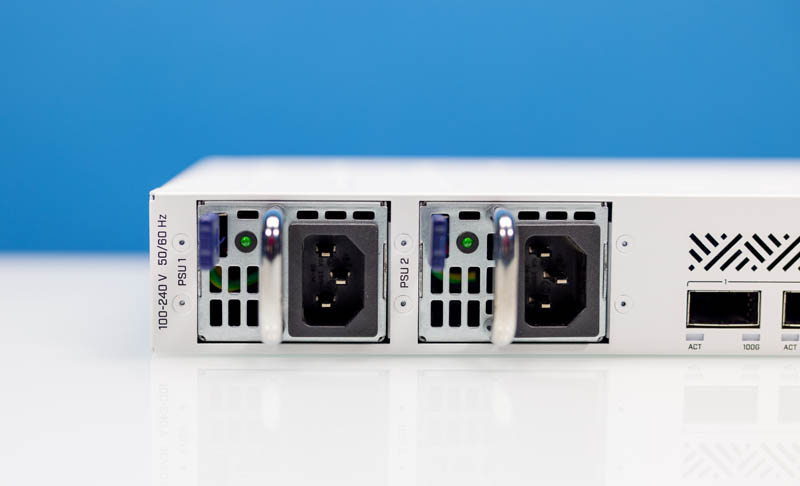
Since this is MikroTik, there are additional power options beyond the redundant AC power supplies. The unit also sports DC power inputs.
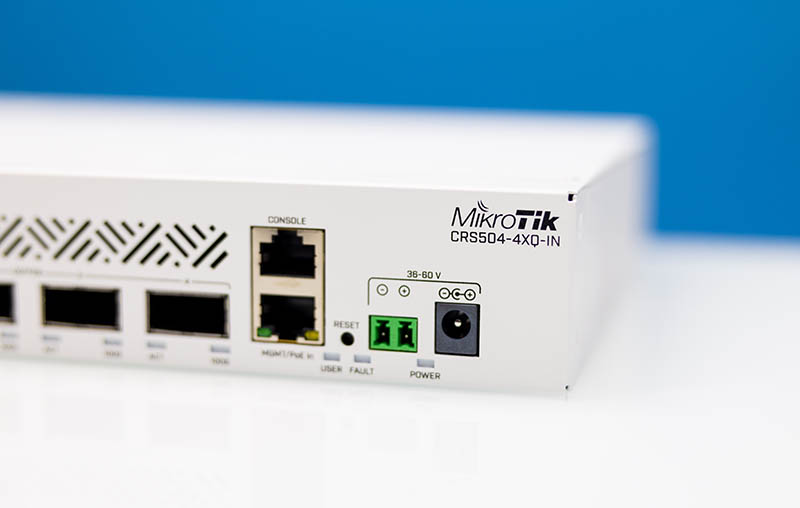
Other ports on the front side are the serial console port and a management port. That 100Mbps management port also functions as a PoE-in power option. This switch not only has redundant AC power but there are two other options as well.
The big feature is, of course, the four QSFP28 ports. These QSFP28 ports are 100GbE ports, but they can also run at 40GbE speeds. They can also be broken out into 4x 25GbE links or 4x 10GbE links each. While this is a 4-port 100GbE switch, it is also a 16-port 25GbE switch.
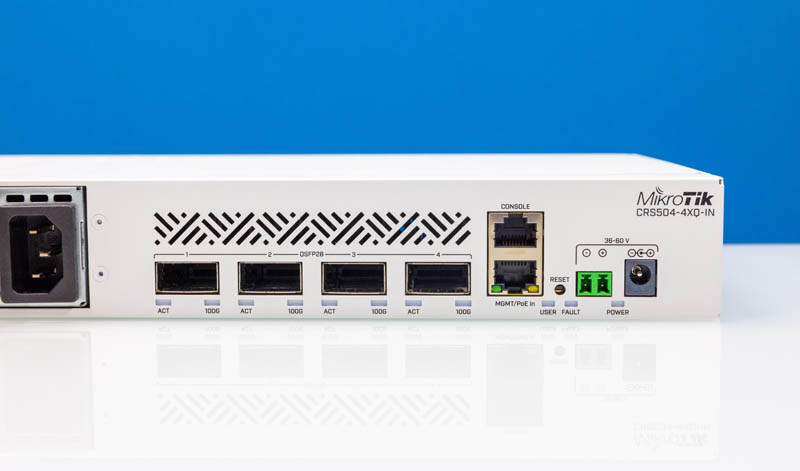
One will probably use either QSFP28 optics, AOCs, or DACs with the switch. We expect QSFP28 to 4x SFP28 DACs to be used with these switches. For example, one could use a 100GbE link to a storage server and a workstation. Eight 25GbE ports would still be available for other nodes and servers.
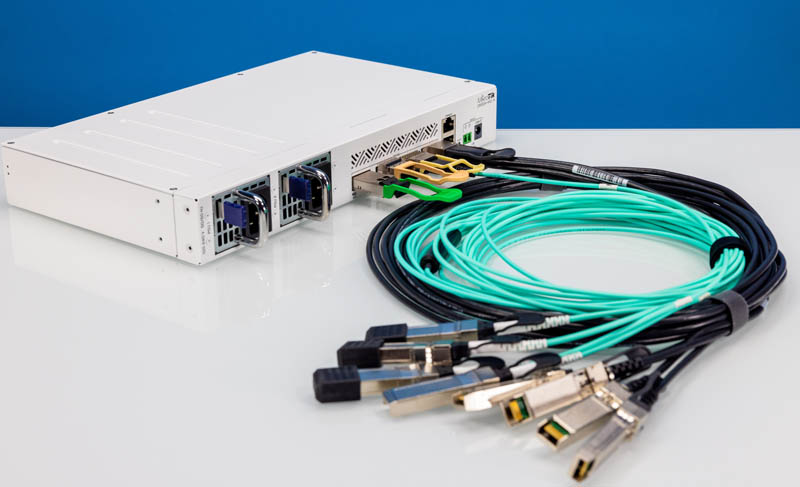
As a quick aside, we know many readers will see that management port and immediately think that is a 1GbE network port. While it shows up on the default bridge in the switch, that 100M port is actually connected through the Qualcomm Atheros QCA9531L 650MHz single-core CPU. That is not fast enough to handle 100Gbps of traffic or, in a lot of cases, even 1Gbps of traffic. Instead, we suggest just using that as a management port only.
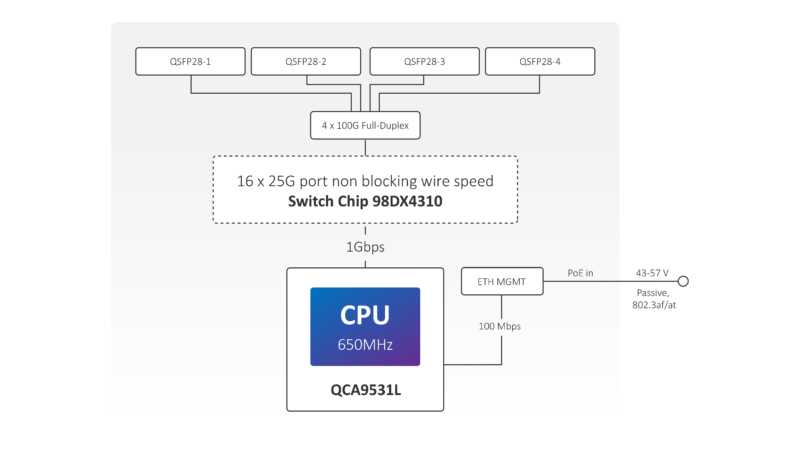
The switch chip is the Marvell Prestera 98DX4310. We suggest keeping all high-speed traffic on that switch chip and off of the CPU.
One side of the switch is just a metal side, but the other has a small vent. The mounting holes for the rack ears are visible on this side as well.
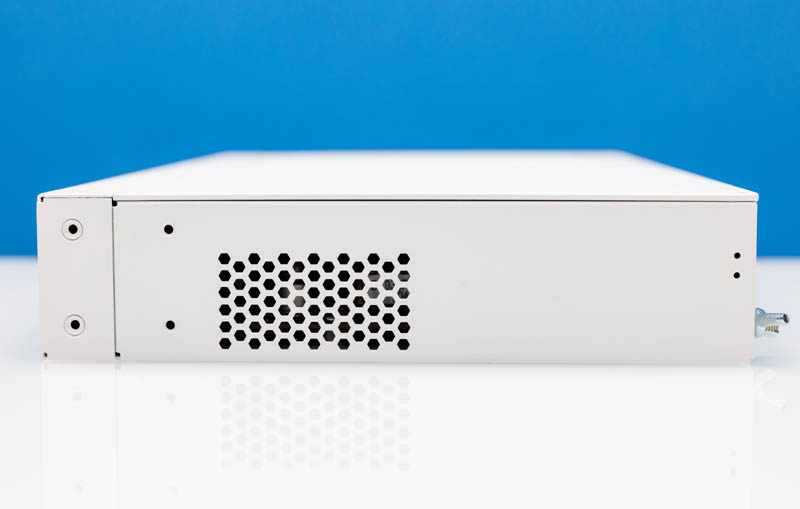
A reason the rear of the switch is so simple, with the second most exciting feature being a grounding nut, is because the unit is designed for dense equipment racks. Many only have cable access on the front. As a result all power and data cables are on the front of the chassis.
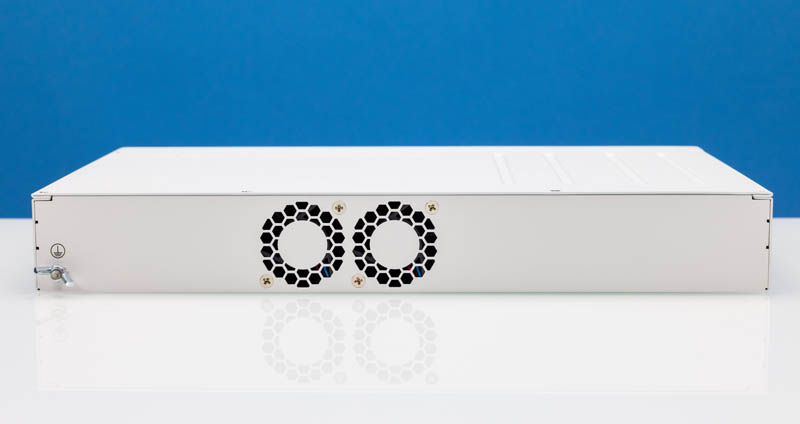
The biggest feature is probably the inclusion of two fans.
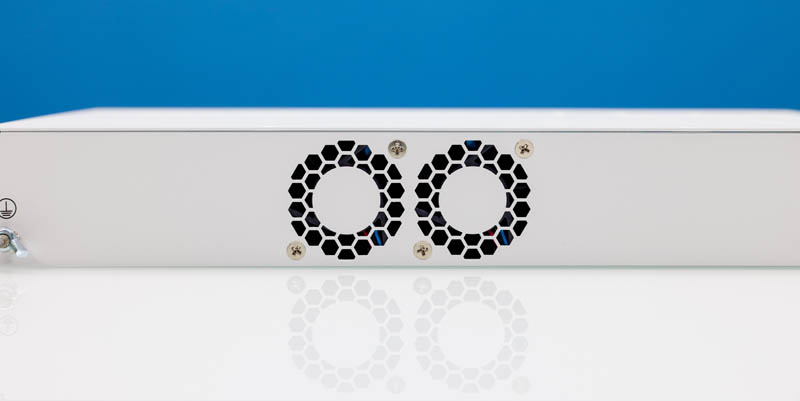
Here is what the switch looks like with the power at the top, then the Marvell and Qualcomm chips and 100GbE ports on the bottom.
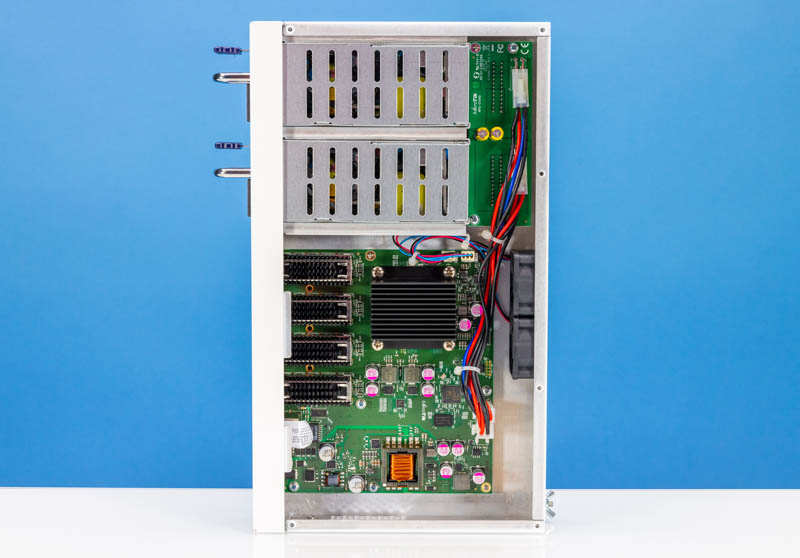
Inside the unit are the two redundant power supplies. There is a small receiver PCB that takes power and turns the gold finger connector on the power supplies to a wired power input to the main switch board.
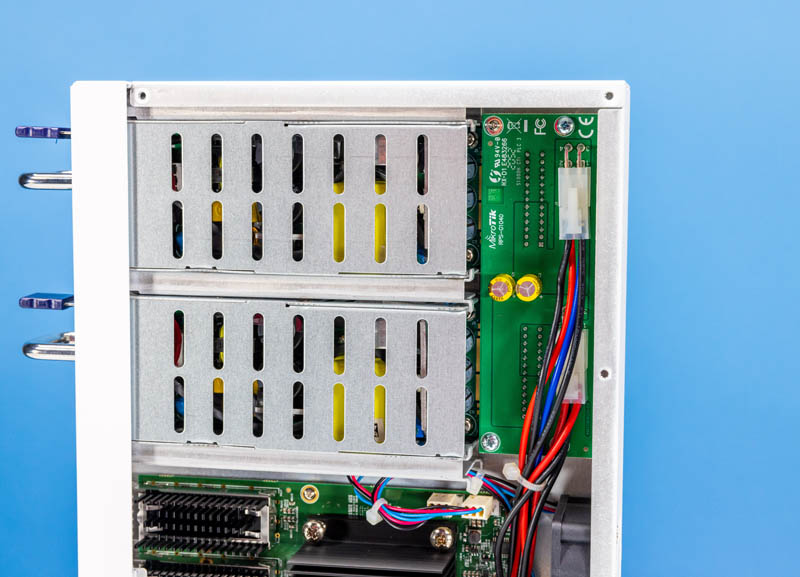
The main switch board has all of the ports, the Marvell switch chip, the Qualcomm Atheros CPU, memory, small amounts of storage, and then the fan outputs.
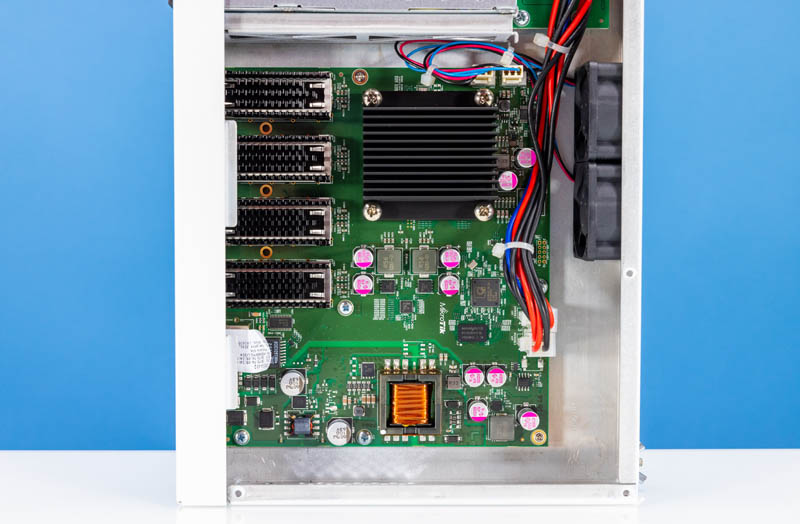
Here is the Marvell Prestera 98DX4310 block diagram that we found:
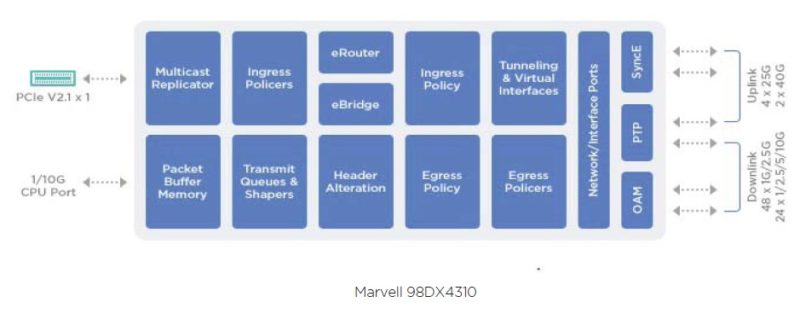
The Prestera chip is under the larger heat sink. On the subject of heat sinks, the QSFP28 cages have enormous heat sinks on them to cool the optical modules. Roughly half of the power consumption in the CRS504 is due to the QSFP28 modules.
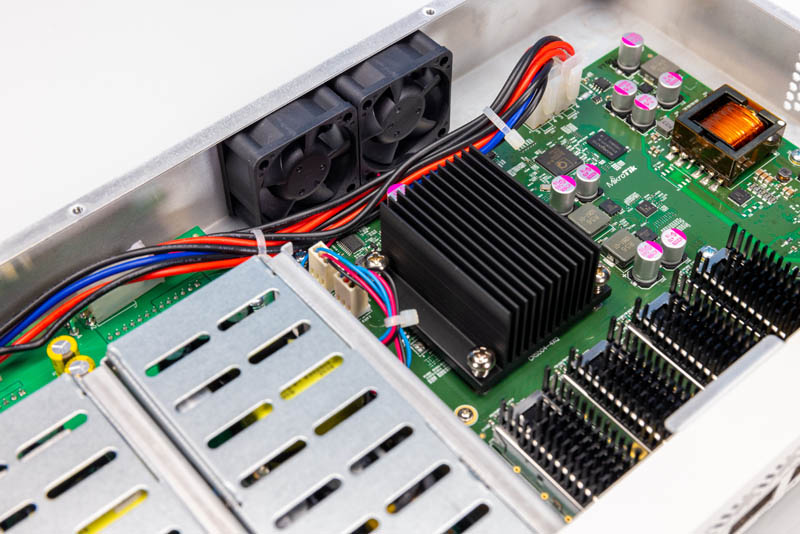
Something we know that many of our readers will want to see is the fan configuration. There are two 1U 40mm fans. These are 3-pin fans. While many of our readers will see this combination and think about a Noctua fan replacement, that may not be needed here.
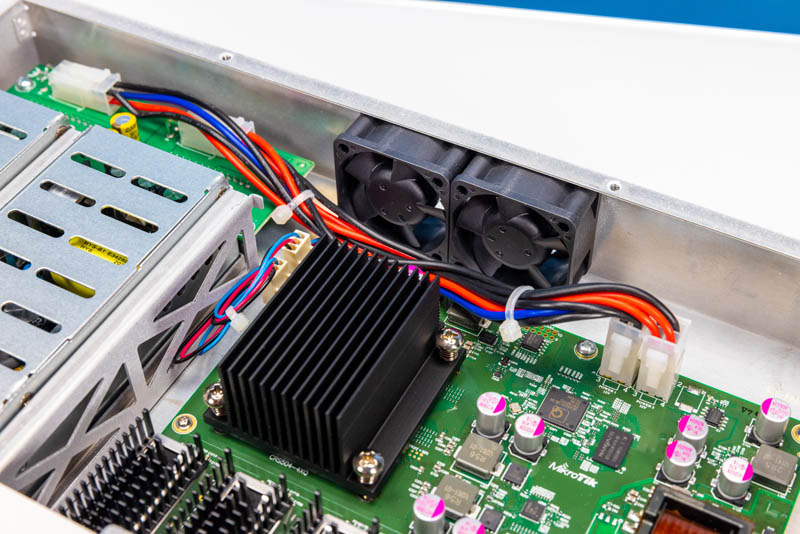
Next, let us get to the management.

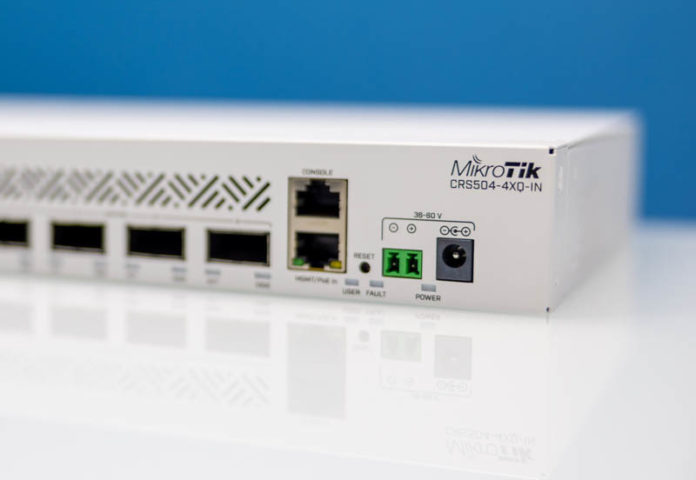



IF my old data center pals decide to give me a couple used 2U/4Node Rome quads in say 2025, THEN this switch (with a couple 100/25Gbit quad breakout cables) would make for an excellent $HOMElab upgrade in my 12U rack.
It’s a shame 100 GbE networking is so power hungry – with the exception of this switch obviously. I recently got hold of a Mellanox ConnectX-6 100 GbE NIC, and the Linux boot messages said the card was requiring 75 watts from the PCIe slot. Even with a quiet fan blowing directly on it, it got too hot to touch, so apparently a faster/noisier fan is needed.
Hopefully newer generations using less power will hit the second hand market soon so we can have 100 GbE at home without turning it into a deafening sauna.
As for MikroTik, my experience hasn’t been fantastic. I first bought a CRS309 (8x 10G switch) and it emitted a buzz and died when I powered it up and had to return it. The second item I bought was an RB5009 which wouldn’t power up, and it turned out they’d listed the wrong specs (since corrected) and said it supported PoE on ports it did not, so again I had to return it as it wasn’t possible to make it work in the scenario I had planned.
The replacement CRS309 worked well enough, but it annoys me that if you change the wrong settings, it can suddenly pass all traffic via the CPU and then without warning your throughput suddenly drops to hardly anything (as mentioned in the article). It’s only after reading the fine print do you discover that while many options and modes are available, only a handful will actually work at wire speed.
So while I used to think MicroTik made some pretty interesting hardware, I’m less keen these days given how much research you have to do over every little detail to make sure the product you’re buying can actually do things that go without saying in other products. I guess that’s just the cost of cheap hardware.
The main issue with Mikrotik is reliability, they still sell a switch that has know issues (CRS354), they still sell a router that tends to reboot/crash for unknown reason (CCR2004) and they seem to find this normal, they just need to find a software workaround..
You have threads on their forum spanning over two years about issues that never get fixed, essential features that get removed from ROS6 to ROS7 and take ages to be reimplemented.
Now their boxes have very nice features for the price, ROS / Winbox is something the big brands should take inspiration from but the fact that you never know how stable their device will be in your use case is really a concern.
Completely agree with netswitch. Its not reliability though its professional integrity.
I agree with netswitch. Having worked almost exclusively in the SMB market over the past decade Mikrotik products were always an option that never was. Their capability to price on paper was a no brainer, but the reality was always that the client would rather purchase supported “big name brand” equipment for double or more the price with peace of mind attached. The homelab and entry level seems to be the only real market they have presence in.
What network devices did you attach it to? Was there any issues with getting the QSFP28 ports to connect to other hardware on the other end? I am just learning about transceivers and it seems to be a minefield!
I have had one of these for the last 2 weeks, and my experience has so far not been great. The device is simple to set up, and with their recommended cables connects ok. However it has dropped out twice now with very little going on. The switch has simply crashed. Power down and up and it starts to work. I am running through various options, but running two connections with 1 QSFTP28 running at 40G -> 10G to a Unifi 48 port switch, and one port running at 100G->25G to a Intel based 710 based card, so its not exactly complex. I only have a few servers to add, but so far I cannot because of reliability. I will probably be jumping out soon and just spending proper cash on a bigger switch, as this has burned too much time now.
Hi, I am new to the networking space. Bought this switch for my home lab. And got 4 used Nic’s to test. I got a 10gb, a 25 gb(Broadcom), a Mellanox cx455a, and a Mellanox cx555a. The 10 and 25 gb nic works well with breakout cable from the crs504. My windows machine was able to recognize either the 10 or 25 gb nic. The other machine of the network is running Truenas and has driver for the 25gb nic. Smb access from windows to truenas was amazing compared to my previous setup of all 1 gb connections. However, I can’t get the cx455a nor the cx555a to work on Windows 11 nor Truenas. They even get recognized in Truenas. In Windows 11, they are recognized in Device manager after I ran the device drivers from Nvidia, but they don’t show up on the Ethernet list nor will they accept dhcp allocation. I manually set their ip and they are not recognized by the switch. RouterOs sees the dac cable on the switch end but no link. Can anyone help me to get the 100 nic’s working in windows?
Can a single QSFP28 port on the switch be split into combined 10Gbe and 25Gbe ports? For example 2x 25gbe and 2x 10gbe? Or must all be the same speed (which are split from one QSFP28 port on the switch)?